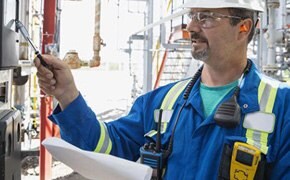Air Monitoring

Air sampling and monitoring is an assessment of air quality determined by the measurement of pollutants and particulates in air. It is used in industrial environments to protect workers and prevent environmental and product contamination. When measuring air contaminants, investigators must consider not only the sampling method but also the phase and identity of the pollutant or particulate of interest.
Related Technical Articles
- Supelco thermal desorption tubes for air sampling applications.
- Frequently Asked Questions - radiello® Products
- For faster sampling rates, shorter sampling times, greater sensitivity and higher capacity allowing longer sampling times, discover our range of radial devices.
- Easy-to-use air sampler offering ultimate sensitivity for collection and measurement of vapor phase and particulate isocyanate monomers and oligomers.
- Solvents are one of the three components of paints. They are petroleum-based chemicals which dissolve the pigment and binding agent for application.
- See All
Related Protocols
- Carbonyl compounds react within the DNPH cartridge to form immobilized hydrazones, which can be subjected to automated desorption and HPLC analysis with UV detection.
- Microscopy is an effective way to determine the nature, size, and source of contamination. In this section, you can find some detailed methods important for optical microscopy, as well as important considerations for scanning electron microscopy (SEM).
- radiello® Diffusive Air Sampling Application - Volatile Organic Compounds (VOCs) Chemically Desorbed With CS2
- Protocol for radiello® Diffusive Air Sampling Application - Nitrogen and Sulfur Dioxide
- Protocol for radiello® Diffusive Air Sampling Application - Anaesthetic Gases and Vapors
- See All
Air sampling methods
Active air sampling involves drawing an air sample through a type of adsorbent media such as a sorbent tube, thermal tube, filter or impinger using an air pump.
Passive air sampling relies on the unassisted molecular diffusion of gaseous agents (analytes) through a diffusive surface onto an adsorbent. This method provides a reliable, cost-effective air quality analysis, because sampling doesn’t involve air pumping but is rather controlled by diffusion. Passive air sampling provides detailed levels of pollutants over a period of time, from days to months, by measuring average pollutant concentrations.
Whole air sampling involves the collection of an entire air sample by drawing air into a containment vessel, stainless steel container, or glass canister. This simple collection method allows testing for compounds of interest directly from the vessel.
Classification of air contaminants
Air contaminants are typically classified as chemical, radiological, or biological contaminants.
Chemical contaminants occur as gases, vapors and particulates. Common chemical contaminants in the air are nitrogen dioxide (NO2), carbon monoxide (CO), formaldehyde, lead, asbestos, ozone, volatile organic compounds (VOCs), and dust or particles (particulate matter). Chemical contaminants are measured by active or passive air sampling.
Radiation monitoring is used to detect non-natural, radiation signals above naturally occurring, background radiation levels.
Biological air contaminants include bacteria, spores, fungi, yeast, microbial toxins, and viruses released from facilities. Other biological contaminants include irritants and allergens, such as pollen and molds. Biological contaminants are monitored using settle or contact plates and Reuter centrifugal samplers that use dedicated agar strips.
Air Monitoring Applications
Air monitoring has various industrial applications where air quality is a concern or a health hazard. Typical applications include the monitoring of agricultural contamination, industrial pollution, and anesthetic gas exposure.
Vapor intrusion is the vapor phase migration of volatile organic inorganic compounds into indoor air spaces from contaminated groundwater or soil.
The production of a variety of petrochemical products often lead to the production of hazardous byproducts that can have negative health and environmental effects. Refinery workers and surrounding communities are at risk of exposure by the volatilization of hazardous materials from the routine sampling, surface spills, leaking of underground storage tanks into soil and groundwater supplies.
By blocking pain sensations, anesthetic gases allow patients to undergo surgical or other procedures without distress. Issues with dosing technique, equipment leaks or failures, waste anesthetic gases, can pose a risk to healthcare workers.
People living and working in rural areas are at risk of exposure to a wide range of pollutants emitted from agricultural operations. Exposure to pesticides and herbicides is a significant concern, as roughly only 85% of sprayed airborne pesticides reach their target destination. In addition to the risk of exposure to the active chemical agent, workers who spray or deposit these agents are also at risk of solvent exposure.
To continue reading please sign in or create an account.
Don't Have An Account?